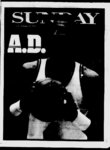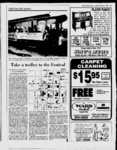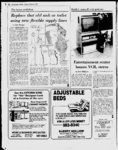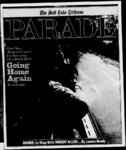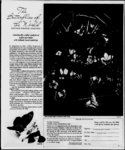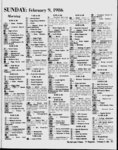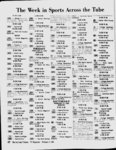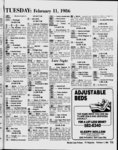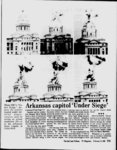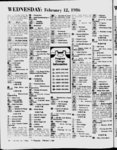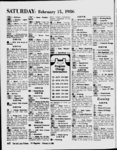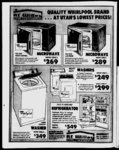| OCR Text |
Show aritnuu Jim It Lake Sunday Section 9, 19Sli Murr.inj'-Fcbru- arv A Page 7 ri b u in 16 lull tor in Is Common Carrier Lt'tti'rs BLM Wilderness Advoeacv: Promise for Utahs Future One of the most important gifts Itahns could leave to their children and grandchildren is an opportunity to toexperience the spectacular beauty, tal isolation and utter silence that can still be found in the vast desert regions of this state. The Bureau of Land Management's wilderness study process provides an opportunity to secure that gift From the cliffs of the San Hafael Beef to the alpine meadows high in the Deep Creek Range, from redrock canyons of the Escalante River to the barren sagebrush slopes of the Wah Wah Mountains, there are vast expanses of land in Utah that remain largely untouched by mans activities and deserve to be preserved for future generations. The BLM estimates that 3.2 million acres of its lands in Utah are essentially wild. Conservation groups believe the figure is actually closer to 5 million acres. Whatever the figure, it's a lot of land. This abundance of wild lands means, quite simply, that those of us living in Utah in the 1980s are still privileged to have literally thousands of places close at hand to escape the noise, traffic and hassles of modern society and gaze with awe at the natural world. Ready access to truly wild and beautiful places is one of the reasons many people live in Utah and others desire to settle here. It's a resource thats found in few other regions of this nation. Although abundant. Utah's wild places are vulnerable. Growing cities, expanding road systems, new industry, agriculture and unregulated recreational uses are steadily encroaching on the remaining wilderness in Utah. If not protected, some of the most spectacular of these lands will be irreparably damaged by mans activities within the next several decades. It's obvious that not all of the wild lands in Utah can or should be designated as wilderness. Some contain important minerals and other natural resources, and others are located in areas where development is inevitable. But many of the tracts are spectacular and of little use for anything else. The 1.9 million acres of wilderness recommended last week by the BLM mark a good beginning at identifying appropriate areas for the protective designation. These are some of the most spectacular of the wild lands and have few, if any, conflicts. All this acreage should be automatically designated wilderness. The next step should be to identify those lands which, because of moderate resource conflicts, were not included in the 1.9 million acres of wilderness recommended by the BLM. Because these are the wild lands at the highest risk of being lost, but because they could also contain resources on which the nation may someday rely, they should be subject to the most careful study and extensive public debate before a decision is made on a future wilderness status. Change for Haili Haiti has evicted its bungling dictator. Whether that means improveCaribbement for this an land is another matter. long-distress- When Jean-Claud- e Doc Baby Duvalier fled his presidential office, joined by family and cronies, aboard a U.S. Air Force plane bound for France, the departure was cause for genuine celebration, in Haiti and among the many Haitian refugees congregated in the United States. But the "morning after could be grim. The Duvalier regime, ruthless in 1957 by father. "Rapa Doc. ruled through savage intimidation. And although such methods were said to soften during "Baby Doc's" reign, following the founder's death in 1971, last week's forced abdication was doubtless hastened by continued political and civil rights persecution. But more was coup-founde- d livestock disease and pervasive government corruption, Haitis food and fiber production floundered. Also, publicity about the prevalence of AIDS among Haitians shattered Haitis once prosperous tourism. Hotels, restaurants and other commerce had accounted for 15 percent of Haiti's jobs. Only 6.5 percent are in manufacturing. But 65 percent of the labor force is agicultural. Unemployment. then, is said to run over 50 percent; with average per capita income estimated at less than $300. Jean-Claude- 's involved. Often described as one of the hemisphere's poorest countries. Haiti was making economic headway. Aided by 300 United States iirms manufacturlow ing export products, exploiting wages and tax concessions, the country's industrial component was grow- ing at a 30 percent annual rate. It's afflicted agricultural segment, however. overwhelmed such progress Battered by a succession of hurricanes. drought, worldwide recession. In an effort to meet mounting financial stress, the Duvalier government recently increased taxes and scaled back some public services. It probably was the last straw. Even former supporters of the regime approved "Baby Docs" ouster. Correcting the situation wont be easy. Massive aid for Haitian agriculture is indicated. As well as financial support for the replacement government. The United States surely will be asked for more than its share. Unless this country wants added turmoil in the Caribbean, causing more refugees forced onto Florida shores, it should accord Haiti more than benign encouragement and attention, so the opportunity for change actually creates a legacy better than the one left behind by the Duvaliers Insurance Firms Need Scrutiny By Bob Hunter and Jay Angoff Special to the Los Angeles Times Last year, just as they had done in 1976, insurance companies dramatically raised the cost of liability insurance for businesses, doctors, local governments and others. Or they simply refused to provide coverage at any price. And, as was the case almost a decade earlier, the industry claimed that huge jury awards and a litigation "explosion" had left it with no choice but to raise rates and cancel policies. Yet judges and juries did not get stingy in the intervening years. Nor did the number of lawsuits decline. Rather, insurance premiums rose dramatically in 1976 and 1985 due to the cyclical nature of the insurance industry. Insurers cut their prices when interest rates, and thus their income from investing the premiums that they collect, are high. They raise rates when interest rates, and thus investment income, are low. They overreact at the top and bottom of the cycle. In 1981, for example, with both interest rates and the rate of return on equity running near 20 percent, insurers were "begging for business, at any price, to get premium dollars to invest, according to the president of a large New York insurance brokerage. Insurers even wrote policies for those harmed in the Las Vegas MGM Grand Hotel fire after the disaster occurred. They believed they would earn more by investing their premiums immediately than they would lose out claims in the future. Today, on the other hand, interest rates have declined. The industry finds itself paying claims on policies that were written back in the days of hyperinflation, when its rates were too low. So, just as it did in 1976, the industry substantially raised rates by an average of 72 percent for general liability policies and reduced coverage. Meanwhile, the e index of almost twice stocks rose by 50 percent as much as the Dow Jones industrial property-casualty-insuranc- Bob Hunter is president of the Aa-tion- Insurance Consumer Organization in Alexandria, Ya. Jay Angoff is the Organization's counsel. To flatten out the insurance cycle, and thus bring down insurance rates and prevent sharp increases in the future. Congress should do the following: Subject the insurance industry to antitrust laws, thus preventing insurers from acting in concert to raise prices. Since 1945 the McCarran-FergusoAct has allowed insurance companies to fix in other indusprices, while price-fixintries is punishable by up to three years in jail. Create a federal office of insurance to monitor the industry and establish standards for state regulators to follow Although insurance is a national. $310 billion business, accounting for 12 percent of our gross national product, only the states regulate the insurance industry. Because state insurance commissions are often understaffed (half the states have no actuaries to analyze rate filings) and have a revolving door" relationship with the industry (state insurance commissioners typically come from and re n g - turn to the industry), state regulation has not always protected the public. Repeal the insurance industry's exemption from Federal Trade Commission jurisdiction. In 1979, after the FTC published a study critical of the industry. Congress prohibited the agency from ever again studying -let alone prosecuting any sector of the insurance industry. There is no principled justification for this exemption Expand the Risk Retention Act. but not which allows manufacturers centers other businesses such as day-car- e to join to buy inand surance at a lower rate. This would preempt state laws prohibiting such group buying. Automobile owners, for example, who must now buy insurance individually, could reduce their premiums by 10 percent a year by buying in groups. Establish a national reinsurance program to be funded by the insurance industry. Reinsurance is insurance for insurance companies: The insurer pays the reinsurer a premium, and the reinsurer agrees to share the risk with the insurer. The reinsurance market is dominated by Lloyds of London. Because neither the federal nor state governments effectively regulate Lloyds, American insurers have no recourse when the British firm raises its rates, as it did last year. An American reinsurance program would compete with Lloyds and exert downward pressure on reinsurance rates, which in turn would enable insurers to reduce their rates. It is the insurance industry, not the legal system, that is most in need of reform. Placing limitations on jury awards will not bring rates down Ending insurance rate cycles will nurse-midwiv- John McLaughlin Lottos: Way to Make Money New-Fashion- ed Newhouse News Service NEW YORK New York state passed a law in 1774 banning lotteries because of their "pernicious consequences" among them encouraging "numbers of laboring people to assemble together at taverns." Things change. Taverns don't sell lottery tickets here. But bodegas do. and a week ago numbers of laboring people were taking the air on Tenth Avenue patiently waiting their turn at a shot at the riches of kings. Across the state, lottery cash registers were ringing up $19,000 a minute. There had been no winner of Lotto 48 since just after Christmas. and the prize stood at $30 million. All you had to do to win was 48 pick six sequentially correct numbers from to 1 The odds on doing that are. according to the Lottery people. 6 million to one. on the theory that each $1 investor gets to play two numbers combinations. This is a bit of a fraud in that the odds on any one ticket hitting are an inflexible 12 million to one and holding two does not quite double your chances No matter, the important thing about the odds is that it guarantees periods when several drawings will go by without producing a winner. so that the pots are rolled over. When they hit $8 million or so. a buying frenzy sets in. To the players, the odds are irrelevant in any event. It is the size of the prize that counts. They are people in pursuit of a dream. The Lottery is a sucker bet. The state charges five times more to book your number than the commission charged by your bookie to get a bet down on the Super Bowl. Its cut from the lottery is three times as high as it takes out of the betting pool at friendly-neighborhoo- horse races. But the trouble with football games and horse races is that you have to put up a lot of money to win a lot of money. Besides, nobody ever won $30 million in a day at the track or in front of a TV set broadcasting a football game Lotteries are in place now in 18 states and the District of Columlike bia. and they generally are viewed as a form of harmless fun bingo games at the parish hall Besides, the money goes for good causes - education and such Thomas Jefferson called them a system "that lays taxes only on the willing. Of course Jefferson was a lottery operator, using the proceeds to pay off sizable personal debts The states don t use their lbttery revenues to pay off debts, necessarily, just to avoid the onerous job of raising taxes New York sold $1.2 billion worth of lottery tickets during fiscal with the state pocketing $6110 million. The numbers in Pennsylvania were about the same. New Jersey, where the lottery is the fourth-larges- t producer of revenues behind the sales tax. income tax and motor vehicle tax. was close behind 1985, lndustr ial Plus Final, official, verified confirmation that McDonnell Douglas Uorp will locate a new plant in Salt Lake City lacked the employment figures mentioned in earlier speculation But the news is encouraging, nonetheless When company otlieiuls and local government spokesmen at last authenticated preliminary press disclosures the number of new jobs, luui leached a "200 to 500 range." The initial. unofficial accounts had whetted appitites for a more spectacular announcement, suggesting the company's arrival in the Salt Lake Metropolitan area could be accompanied by 7,so new jobs However, considered m terms, the difference is n cause for great disappointment Utah and its metropolitan are.c need new and expanding industry Uialyses contend the state must pro ide at lea d 20.000 new jobs a yt,r 'a keep its growing population gainful, employed To do that requires not only actual creation of those jobs, but con tinual siu res, ,ful prospecting loi long-vie- -- ' nem All of this money flowing into state treasuries hasn t been lost on bills for a national lottery have been Washington, where a proffered The states are nervous about this, especially in the Northeast where Connecticut raises almost 6 percent of its money from legal gambling and Maryland even more McDonnell Douglas is an established. highly regarded aeronautics firm The fabricating plant it intends to locate near Salt Lake International Airport, while not quite as large as first suggested, will conspicuously half-doze- n Meanwhile they are in heavy competition wuh each other especially where customers have easy access to New York. New Jersey and Pennsylvania Advertising budgets are on the rise, and New Jersey. horrified bv the news that one of every five of its citizens buys a New York ticket once a month, has changed the rules of its major game The Pick Six numbers pool there will be increased from 39 to 42. hiking the odds on winning from one in 3.3 million to one in 4 2 million, setting the stage for fewer winners of bigger prizes Dazzled by stories of $20 million to $4U million winners placers are no longer turned on by the prospect o u inning a mere million ot carry another of industrial America's "big names" to Utah The companys decision to do major manufacturing here cannot be lost on other corporations also looking for branch opportunities nationwide . State and local economic promotion groups and agencies are already collecting applause for the McDonnell Douglas arrival. They are entitled More to the point, they need now to capitalize on this and similar successes to further promote Utah's economic attributes and advantages two. Not when they could have it all Not when they could, like Pavpiule Consalvo of Staten Island, see their weekly earnings jump trom $42.1 to $21,978 At $1,142,857 a year. Consaho a omit ik lion uotker will be bringing home about what AT and T Chan man Ctiai les Bmw n does, and Brown is the lorpiu no cxoeutr.e m tin- land In the eai ly days of the modem htt-the money mound to hand out $!uu oou or Ini nmo sort ot redistribution, possible As a complement to basic wduMn in Utah. Mi Donnell Douglas now H: comes a distinctive, suitable cummu nity addition May the association al No .1 ways be mutually proud and pH d mote Now the idea is to transbu m the PaulGettcs " . idea was m spread mam, people as m, m .,,, a senate ( 'on sale os into new bret d of inullimiliiunuirc' hex make nioiiex the fashioned wax Thov win it from exerxtmdv es, I it.iMe I new |



















































































































































